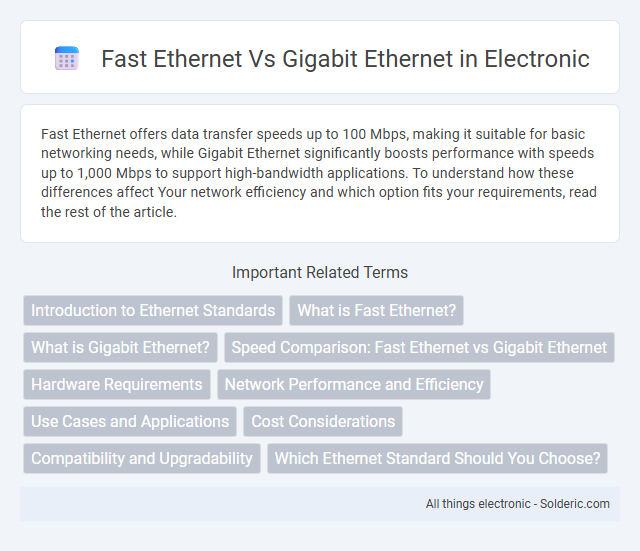Fast Ethernet offers data transfer speeds up to 100 Mbps, making it suitable for basic networking needs, while Gigabit Ethernet significantly boosts performance with speeds up to 1,000 Mbps to support high-bandwidth applications. To understand how these differences affect Your network efficiency and which option fits your requirements, read the rest of the article.
Comparison Table
| Feature | Fast Ethernet | Gigabit Ethernet |
|---|---|---|
| Speed | 100 Mbps | 1 Gbps (1000 Mbps) |
| Standard | IEEE 802.3u | IEEE 802.3ab (copper), IEEE 802.3z (fiber) |
| Cabling | Cat5 UTP, Fiber Optic | Cat5e/Cat6 UTP, Fiber Optic |
| Max Distance | 100 meters (copper) | 100 meters (copper), longer on fiber |
| Use Case | Basic office networks, legacy systems | High-speed data transfer, modern networks |
| Price | Lower | Higher |
| Backward Compatibility | Compatible with Ethernet | Compatible with Fast Ethernet and Ethernet |
Introduction to Ethernet Standards
Fast Ethernet (100 Mbps) and Gigabit Ethernet (1 Gbps) represent two key standards in network technology, defining different data transfer speeds and performance capabilities within the Ethernet family. Fast Ethernet, standardized as IEEE 802.3u, revolutionized network efficiency by offering tenfold speed improvement over traditional Ethernet (10 Mbps), while Gigabit Ethernet, standardized as IEEE 802.3ab for copper and IEEE 802.3z for fiber, further enhances data throughput to 1,000 Mbps. Choosing between these standards depends on your specific networking needs, such as bandwidth requirements and device compatibility, ensuring optimal data transmission and network speed.
What is Fast Ethernet?
Fast Ethernet refers to a network standard that transmits data at 100 megabits per second (Mbps), significantly faster than the traditional 10 Mbps Ethernet. It primarily uses twisted-pair or fiber optic cabling to connect devices in local area networks (LANs). Understanding Fast Ethernet helps you evaluate the performance and compatibility of your networking equipment compared to newer standards like Gigabit Ethernet.
What is Gigabit Ethernet?
Gigabit Ethernet is a network technology that delivers data transfer rates up to 1,000 Mbps, which is ten times faster than Fast Ethernet's 100 Mbps capacity. This higher speed supports more efficient data transmission, making it ideal for bandwidth-intensive tasks such as video streaming, large file transfers, and online gaming. Upgrading to Gigabit Ethernet can significantly enhance your network's performance and reduce bottlenecks in data communication.
Speed Comparison: Fast Ethernet vs Gigabit Ethernet
Fast Ethernet operates at 100 Mbps, while Gigabit Ethernet delivers speeds up to 1 Gbps, offering a tenfold increase in data transfer rates. This speed difference significantly enhances network performance for bandwidth-intensive applications such as video streaming, large file transfers, and online gaming. Many modern networking devices and infrastructure now prioritize Gigabit Ethernet for improved efficiency and future-proofing.
Hardware Requirements
Fast Ethernet requires Cat5 twisted-pair cables and supports speeds up to 100 Mbps, relying on older hubs or switches compatible with 100Base-T standards. Gigabit Ethernet demands higher-quality Cat5e or Cat6 cables to handle speeds up to 1 Gbps and uses more advanced switches and network interface cards (NICs) designed for 1000Base-T performance. The hardware upgrade from Fast Ethernet to Gigabit Ethernet involves ensuring all devices and cabling support the increased data transfer rates to prevent bottlenecks.
Network Performance and Efficiency
Gigabit Ethernet delivers network performance that is up to 10 times faster than Fast Ethernet, with speeds of 1 Gbps compared to 100 Mbps, enabling quicker data transfer and reduced latency for bandwidth-intensive applications. The enhanced efficiency of Gigabit Ethernet minimizes network congestion and supports simultaneous high-demand tasks such as video streaming, large file transfers, and cloud computing. Fast Ethernet remains suitable for basic networking needs, but Gigabit Ethernet is essential for modern environments requiring higher throughput and improved overall network responsiveness.
Use Cases and Applications
Fast Ethernet, offering speeds up to 100 Mbps, is ideal for small businesses or home networks where basic internet browsing, email, and file sharing are common. Gigabit Ethernet, delivering 1,000 Mbps, suits high-demand environments like data centers, video streaming, and gaming, supporting large file transfers and low latency applications. Your choice depends on the network's bandwidth requirement and the scale of connected devices requiring high-speed, reliable connectivity.
Cost Considerations
Fast Ethernet typically costs less than Gigabit Ethernet due to lower hardware and cabling expenses, making it a budget-friendly option for small-scale or legacy networks. Gigabit Ethernet requires higher-grade cabling and more advanced network interface cards, which increases initial investment but delivers tenfold speed improvements. Organizations prioritizing cost savings over maximum performance often choose Fast Ethernet to maintain basic connectivity at reduced expense.
Compatibility and Upgradability
Fast Ethernet supports speeds up to 100 Mbps and is compatible with older networking devices, making it suitable for basic LAN setups and legacy equipment. Gigabit Ethernet offers tenfold speed improvements at 1 Gbps and maintains backward compatibility with Fast Ethernet, allowing for seamless upgrades without replacing existing cabling or hardware. Your network can evolve efficiently by integrating Gigabit Ethernet to enhance data transfer rates while preserving compatibility with current infrastructure.
Which Ethernet Standard Should You Choose?
Choosing between Fast Ethernet and Gigabit Ethernet depends on your network speed requirements and budget. Gigabit Ethernet offers data transfer rates of up to 1,000 Mbps, making it ideal for high-demand applications like video streaming, gaming, and large file transfers, while Fast Ethernet provides 100 Mbps suitable for basic internet browsing and standard office tasks. Your decision should consider current and future bandwidth needs to ensure optimal performance and scalability.
Fast Ethernet vs Gigabit Ethernet Infographic

 solderic.com
solderic.com